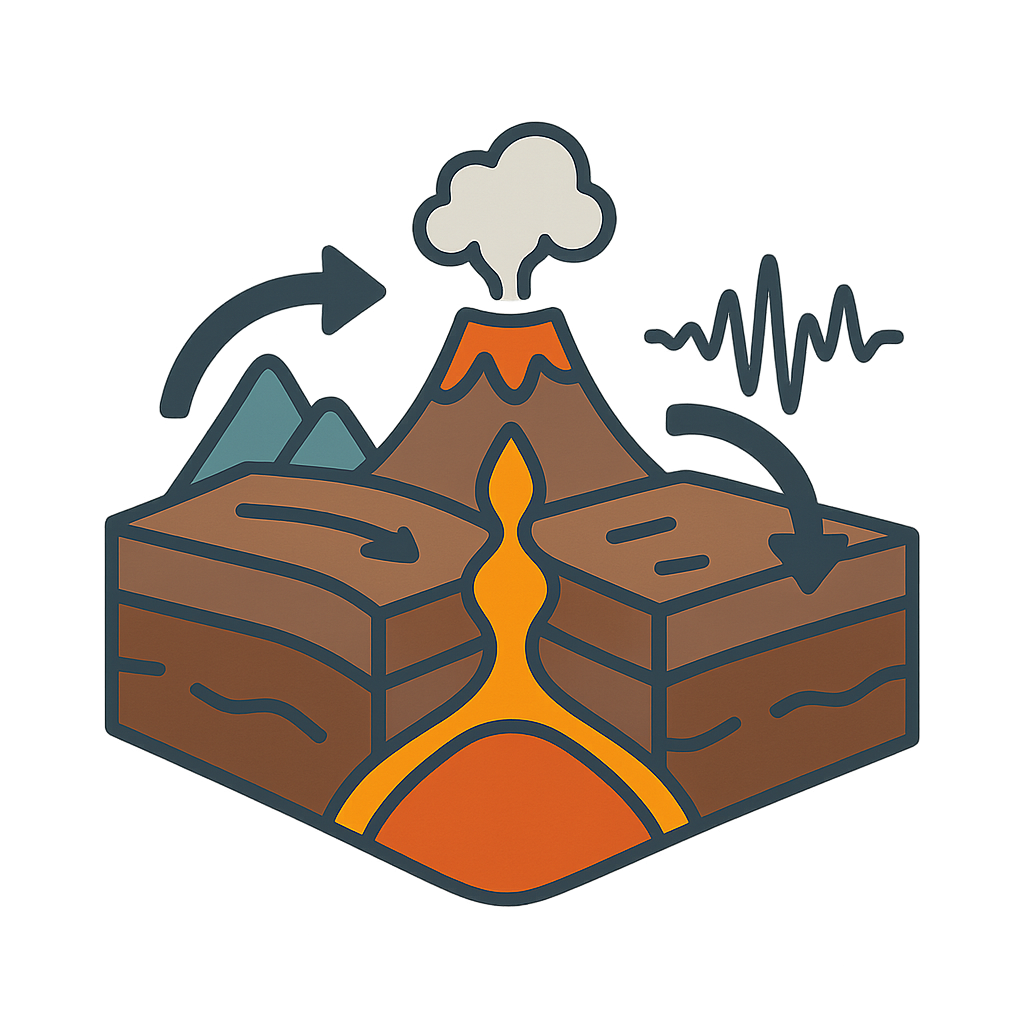The Earth's Giant Jigsaw Puzzle
Have you ever felt a tiny rumble under your feet, so quiet you wondered if you imagined it. Or maybe you've seen a tall, pointy mountain that seems to scrape the bottom of the clouds. That’s me, stirring in my sleep. For millions and millions of years, I've been the slow, sleepy giant just beneath the surface of the Earth, a hidden power that shapes everything you see. I stretch and yawn, and when I do, the ground above me wrinkles up like a blanket, creating huge mountain ranges like the Himalayas. I can push and pull, carving out deep trenches in the ocean floor where sunlight has never touched. For a long, long time, nobody knew I was here. They just saw the world I was shaping, a world of constant, slow-motion change. People would look at maps and scratch their heads in confusion. Can you imagine looking at a map and noticing something that just doesn't seem right. They saw how the long, bumpy coast of South America looked like it could snuggle right up to the coast of Africa. It was as if the world was a giant jigsaw puzzle, and two huge pieces had somehow drifted apart. They wondered, could these great lands have once been connected. It was a wonderful, puzzling mystery.
Then, in the early 1900s, a very curious man named Alfred Wegener came along. He was a German scientist who loved looking at weather patterns and exploring cold, icy lands, but his greatest passion became the Earth's continents. He saw the puzzle pieces, too, and he couldn't stop thinking about them. He began to gather clues like a great detective on a planet-sized case. On his world map, he noticed that fossils of the same ancient plants and animals were found on continents that were now thousands of miles apart, separated by vast oceans. How could a little lizard that couldn't swim have crossed the entire Atlantic Ocean. It just wasn't possible. He also found that rock formations and ancient mountain ranges on the coast of Africa matched up perfectly with those in South America, like two halves of a torn photograph. On November 1st, 1912, he bravely shared his big idea with the world. He called it "continental drift." He proposed that all the continents were once joined together in a single gigantic supercontinent he named Pangea, which means "all lands." But when other scientists asked him the big question—how. How did the continents move. He didn't have the answer. He guessed that maybe they just plowed through the ocean floor, but that didn't seem right to anyone. Because he couldn't explain the engine that moved the continents, most people dismissed his idea as just a silly fairy tale.
For many years, Alfred's incredible idea was mostly forgotten, like a dusty old book on a high shelf that no one bothered to read. He passed away on an expedition to Greenland, never knowing that he would one day be proven right. Decades later, during the 1950s and 1960s, humans built amazing new tools that let them explore a world they had never seen before: the bottom of the deep, dark ocean. Using ships equipped with a special sound-mapping tool called sonar, they sent pings down into the water and listened for the echoes to paint a picture of the ocean floor. What they found was absolutely astonishing. Running right down the middle of the Atlantic Ocean was a gigantic underwater mountain range, with a deep valley cutting through its center. They called it the Mid-Atlantic Ridge. As they studied it more, they discovered something even more incredible. Hot, melted rock, or magma, was constantly bubbling up from inside the Earth right at the ridge, cooling and forming brand new ocean floor. This new crust was pushing the older crust away on both sides, like two giant conveyor belts moving in opposite directions. This was it. This was the missing piece of the puzzle. This process, which they named "seafloor spreading," was the powerful engine that Alfred Wegener had been looking for all along. It was the force that was slowly pushing the continents of South America and Africa apart.
Finally, with the mystery of the moving continents solved, people could understand me and give me my proper name. I am Plate Tectonics. You see, the Earth's outer shell, its crust, isn't one solid piece like a perfect eggshell. It's actually broken into many giant, shifting plates that float on the hotter, softer layer of rock below. I am the force that is always, always moving them. It’s a very slow dance, just a few centimeters a year, about as fast as your fingernails grow. But over millions of years, that slow dance changes the face of the entire planet. When my plates crash into each other, they can push up mighty mountains. When they slide past one another, their stuck edges can suddenly slip, causing the ground to shake in an earthquake. And when one plate slides under another, it can melt and create fiery volcanoes that burst with glowing lava. By understanding me, scientists can now predict where these events are most likely to happen, helping to design stronger buildings and keep people safe. I am the reason our planet is alive and always changing, creating new islands, new mountains, and new oceans. I am the grand artist of the Earth, and my beautiful work is never done.
Reading Comprehension Questions
Click to see answer
